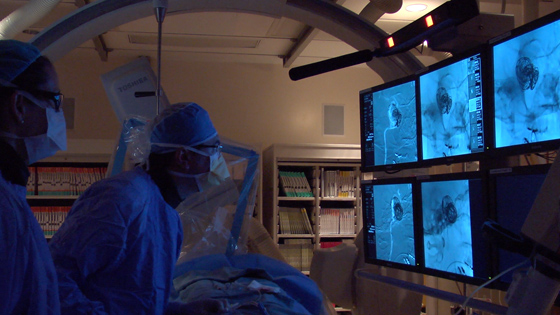
This past summer, Dr. Vitor Pereira performed Canada’s first procedure using the Pipeline Flex, a new treatment for brain aneurysms.(Photo: UHN)
This past summer, a young woman who had just given birth to her third child ended up at Toronto Western Hospital with a diagnosis of a giant aneurysm in one of the arteries in her brain. Her treatment options were limited and there was a risk of rupturing the aneurysm, which could cause bleeding in her brain or a stroke.
Fortunately, the timing for the patient meant that she was treated by Dr. Pereira, who arrived a few months prior from Switzerland where he was the head of the interventional neuroradiology division at the University of Geneva.
Dr. Vitor Pereira, a neuroradiologist with the Joint Department of Medical Imaging at Toronto Western Hospital, was able to perform the lifesaving procedure for his patient using a new technology called the Pipeline Flex – a first in Canada. There have been two additional cases performed successfully making the Toronto Western Hospital the most experienced hospital with this technology in North America.
A world leader at UHN
As an expert on the management of intracranial aneurysms, he is a world leader in the use of this technology and recently published study in the Journal of
NeuroInterventional Surgery, which shows the effectiveness and efficacy of the procedure.
"This treatment is a breakthrough for patients who have very large and complex brain aneurysms," said Dr. Pereira. "It is very exciting to bring this treatment to Canada and North America and work for a centre that will help patients, some of whom might have otherwise been told there was no treatment for them."
An aneurysm is an abnormal, weak spot on a blood vessel that causes an outward bulging or ballooning of the arterial wall. It is often treated surgically, by opening the skull to reach the aneurysm or with an endovascular procedure using coils and stents. With both options the goal is to stop the blood flow to the aneurysms so that it stops growing and reduces over time. But when aneurysms are very large or complex, traditional treatments can be too risky, leaving the patients with no other option.
Better control and flexibility
The technology of the Pipeline Flex builds on the treatment of using coils and stents by giving neuroradiologists the ability for navigation inside the aneurysm and the precise stent placement over the aneurysm neck.
The Pipeline Flex device features a braided cylindrical mesh tube that is implanted across the base or neck of the aneurysm. This new device is repositionable and designed for even more accuracy and controlled placement.
"Many things must be considered when treating a brain aneurysm – it could be a region of the brain that is technically difficult to access or involve arterial trunks and branches or the wall structure," said Dr. Pereira. "We are constantly looking for ways to improve the diagnosis and care of this condition, and this new treatment will save lives."
Related:
